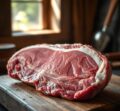Refreezing uncooked sausage is a topic that often sparks debate in the kitchen, but it’s not as tricky as it may seem. Many people wonder whether they can safely refreeze sausages after they’ve been thawed, and the good news is – yes, you can! However, there are some key guidelines to follow to maintain the sausage’s flavor, texture, and safety. In this guide, we’ll walk you through the best practices for refreezing uncooked sausage, so you can confidently keep those links in your freezer without worrying about compromising quality. So, let’s dive in and take the mystery out of refreezing sausage!
Can You Refreeze Uncooked Sausage?

When it comes to handling uncooked sausage, one common question that arises is whether it’s safe to refreeze it after it’s been thawed. The short answer is: yes, you can refreeze uncooked sausage, but the process comes with several important considerations to ensure both safety and quality.
The main concern when refreezing uncooked sausage is the potential growth of harmful bacteria. When food is frozen, it slows down bacterial growth, but once thawed, bacteria can begin to multiply. If uncooked sausage is thawed under the wrong conditions, such as at room temperature, bacteria can proliferate to unsafe levels. However, if the sausage has been thawed properly-either in the refrigerator or through methods like a cold-water bath-and not left out for extended periods, it is generally safe to refreeze.
That being said, freezing and thawing multiple times can impact the sausage’s texture and flavor. The process causes the water in the sausage to form ice crystals, which can damage its structure and make it mushy or dry upon reheating. The more times sausage is frozen and thawed, the greater the impact on its overall quality. As a result, while you can refreeze uncooked sausage, it’s important to understand the risks and the potential decline in the quality of the product.
How To Refreeze Uncooked Sausage?
Refreezing uncooked sausage requires a bit of care to ensure that both the safety and quality of the meat are maintained. Here’s a step-by-step guide on how to do it:
1. Thaw Properly First
Before even considering refreezing, you must thaw the sausage correctly. The safest method is to thaw uncooked sausage in the refrigerator. This ensures that the sausage remains at a safe temperature throughout the process, preventing bacteria from growing. This can take anywhere from 12 to 24 hours, depending on the size and number of sausages.
If you’re in a hurry, you can use a cold-water bath, where the sausage is sealed in an airtight plastic bag and submerged in cold water, changing the water every 30 minutes. This method is faster than refrigerator thawing but still keeps the sausage at a safe temperature.
2. Check The Sausage For Quality
Before refreezing, inspect the sausage for any signs of spoilage. If it smells off, feels slimy, or has changed in color, it’s best to discard it rather than refreeze. The safer choice is always to err on the side of caution when it comes to food safety.
3. Package The Sausage Properly
To refreeze uncooked sausage effectively, ensure it’s wrapped properly to minimize exposure to air. Use freezer-safe, airtight packaging, such as vacuum-sealed bags, heavy-duty plastic wrap, or freezer paper. If you use a bag, squeeze out as much air as possible before sealing it. This helps prevent freezer burn, which can damage the sausage and negatively impact its flavor and texture.
4. Label The Packaging
Don’t forget to label your sausage with the date it was thawed and refrozen. This allows you to keep track of how long it’s been in the freezer and helps ensure you use it within a reasonable timeframe. It’s best to consume refrozen sausage within 1-2 months, although it can be safe beyond that period, its quality may decline.
5. Freeze Promptly
After properly packaging the sausage, place it in the coldest part of your freezer. The goal is to get the sausage back to freezing temperatures as quickly as possible to prevent the growth of any bacteria.
Quality Impact
While you can refreeze uncooked sausage, it’s important to consider how doing so affects the sausage’s overall quality. Freezing and thawing cause ice crystals to form inside the meat, which can break down the cellular structure and lead to changes in texture. Here’s what you can expect:
Texture
The most noticeable impact of refreezing uncooked sausage is the change in texture. Sausage is often made with a mix of fat and meat, and freezing causes the water in the fat and meat to turn into ice crystals. These ice crystals puncture the muscle fibers and fat cells, causing them to lose moisture when thawed. The result? A potentially drier, more crumbly sausage with a less appealing mouthfeel.
Flavor
While refreezing won’t drastically change the flavor of sausage, it can diminish it slightly. The ice crystals that form during freezing can break down fats and proteins, and this may lead to a loss in the rich, savory flavors that sausages are known for. Additionally, the risk of freezer burn (when air reaches the sausage and dries it out) can lead to unpleasant off-flavors.
Moisture Loss
The moisture loss during the refreezing process also plays a role in the final outcome. When sausage is cooked after being refrozen, it might release more moisture than fresh sausage, causing it to dry out faster in the pan or grill. This can result in a less juicy and satisfying eating experience.
While these quality impacts may not be drastic, they can be noticeable, particularly if the sausage was initially high quality. So, if you’re planning to refreeze uncooked sausage, consider using it in recipes where texture and moisture loss won’t be as critical, such as in casseroles, soups, or stews.
Refreezing uncooked sausage is possible, but there are several factors to keep in mind. From a food safety standpoint, as long as the sausage is thawed properly and has not been sitting at room temperature for too long, it’s generally safe to refreeze. However, refreezing multiple times can significantly impact the texture and flavor of the sausage, so it’s best to do so only once.
If you choose to refreeze, make sure to do so as soon as possible after thawing, use proper packaging, and label your sausages to ensure you don’t keep them in the freezer for too long. While the refreezing process can lead to some quality loss, it’s a viable option if you need to extend the shelf life of uncooked sausage or avoid wasting leftovers.
Ultimately, while refreezing isn’t ideal for maintaining the best possible sausage experience, it’s a convenient and safe way to handle sausages when done correctly. If you’re planning to refreeze your sausage, just know that a little compromise on quality might be the price you pay for convenience!
Is It Safe To Refreeze Uncooked Sausage?
When it comes to food safety, particularly with meats like sausage, it’s crucial to follow proper guidelines to ensure both flavor and health are preserved. Refreezing uncooked sausage is a practice that many might be tempted to try after they’ve thawed it but didn’t use it all. However, whether it’s safe to refreeze uncooked sausage depends on several factors.
First, you need to consider how the sausage was initially thawed. If it was defrosted in the refrigerator, it is generally safe to refreeze uncooked sausage. The slow, controlled temperature of the fridge prevents the sausage from reaching the "danger zone" (between 40°F and 140°F), where bacteria can grow. In this case, refreezing is fine as long as you do it promptly (within a day or two of thawing).
However, if you thawed the sausage using methods like the microwave or hot water (which can cause it to partially cook), the safety of refreezing becomes more questionable. Once the sausage reaches room temperature or above, bacteria multiply rapidly, and refreezing can lock in these potential pathogens. In this scenario, it’s best not to refreeze the uncooked sausage to avoid foodborne illness risks.
Another important aspect to consider is the quality of the sausage. Refreezing can lead to the degradation of its texture and flavor, especially if it’s been frozen and thawed multiple times. Repeated exposure to freezing and thawing cycles can cause moisture loss, making the sausage drier, less flavorful, and potentially tougher.
Signs That Uncooked Sausage Should Not Be Refrozen
Knowing when uncooked sausage should not be refrozen is just as important as knowing when it’s safe to do so. There are several clear signs that indicate your sausage is no longer safe to refreeze:
- Off Smell: Fresh sausage typically has a slightly savory, seasoned aroma. If your sausage has a sour, rancid, or off-putting odor, it’s a clear sign that bacteria have begun to proliferate, making it unsafe to eat, let alone refreeze.
- Slimy or Discolored Texture: When sausage starts to spoil, its texture can become slimy or tacky to the touch. Additionally, a change in color (such as turning grey or brown) suggests that the sausage is past its prime and should be discarded rather than refrozen.
- Extended Thawing Time: If the sausage has been left out at room temperature for longer than two hours (or one hour if the ambient temperature is above 90°F), it has entered the bacterial danger zone. At this point, refreezing is not an option, and you should discard the sausage.
- Visible Ice Crystals or Freezer Burn: If the sausage shows signs of freezer burn, like dry patches or ice crystals forming on the surface, it has likely been frozen for too long or thawed and refrozen before. While freezer burn won’t make the sausage unsafe, it will drastically affect the taste and texture, making it unappealing to eat.
- Previously Frozen and Thawed Sausage: If the sausage has already been thawed and refrozen once before, its safety and quality are compromised. At this point, it should not be refrozen again, as it’s prone to contamination and texture degradation.
Common Refreezing Mistakes
While refreezing uncooked sausage can be safe under the right conditions, there are some common mistakes people make that could lead to health risks or a reduction in quality. Here are a few to avoid:
- Thawing in Warm Water or Microwave: As mentioned, defrosting sausage quickly with hot water or a microwave causes parts of the sausage to reach an unsafe temperature. This uneven thawing can allow bacteria to grow in certain spots, making refreezing unsafe.
- Not Refreezing Immediately: After thawing in the refrigerator, it’s crucial to refreeze the sausage within 24 hours. Waiting too long to put it back in the freezer increases the risk of bacterial growth, making it unsafe to refreeze.
- Refreezing Multiple Times: Each time sausage is frozen and thawed, the quality degrades. Refreezing multiple times leads to a loss of flavor and texture, and can cause freezer burn. More importantly, it increases the chances of foodborne pathogens becoming a concern.
- Not Properly Wrapping the Sausage: When refreezing uncooked sausage, it’s essential to wrap it securely in plastic wrap, aluminum foil, or freezer-safe bags. Air exposure leads to freezer burn, which can ruin the flavor and texture. Sealing it properly prevents moisture loss and protects the sausage from contamination.
- Failing to Label and Date: Many people forget to label items in the freezer, which can lead to confusion about how long the sausage has been stored. Refrozen sausage should be labeled with the date it was initially frozen and the date it was refrozen. Ideally, you should consume it within one to two months for the best quality.
Tips And Tricks
To ensure that refreezing uncooked sausage doesn’t ruin the taste or pose a health risk, here are some practical tips and tricks to keep in mind:
- Thaw Safely: The best way to thaw uncooked sausage is in the refrigerator. This allows it to thaw slowly and stay at a safe temperature, preventing bacterial growth. For quicker thawing, you can use the defrost function on your microwave, but you should cook the sausage immediately afterward.
- Portion Control: When purchasing sausage in bulk or preparing it in larger quantities, consider portioning it into smaller, individual servings before freezing. This way, you can thaw only the amount you need, reducing the chances of needing to refreeze leftover sausage.
- Use Freezer-Safe Packaging: Invest in vacuum-sealed bags or freezer-safe wraps for storing sausage in the freezer. These options will reduce the risk of freezer burn and ensure your sausage stays fresh longer.
- Track Time in the Freezer: Keep a note of how long the sausage has been in the freezer. While most sausages last up to two months in the freezer, the longer they stay, the more the quality will degrade. Refrozen sausage should ideally be consumed within one month of its initial freezing date.
- Avoid Refreezing After Cooking: If you’ve cooked sausage and have leftovers, it’s not advisable to refreeze it. Cooked sausage can be refrozen, but it tends to lose its moisture and flavor when reheated. Only refreeze cooked sausage if you have to, and remember to consume it within a few weeks.
- Freeze Uncooked Sausage as Soon as Possible: If you’re not sure when you’ll be using your sausage, freeze it as soon as you bring it home from the store. This will preserve its freshness and texture, giving you a longer window of opportunity for future use.
Conclusion
Refreezing uncooked sausage is not always a straightforward process, and while it can be done safely, it requires careful attention to thawing methods, time management, and food storage. The general rule of thumb is that uncooked sausage can be refrozen if it was thawed properly in the refrigerator, but it must be done so quickly, and only once. If the sausage shows any signs of spoilage, it’s best to discard it. By following safe food handling practices, such as properly thawing, sealing, and labeling your sausage, you can extend its shelf life without sacrificing flavor or risking your health. As a general principle, though, it’s always better to be cautious: when in doubt, don’t refreeze.


